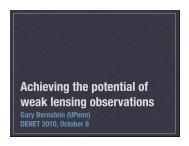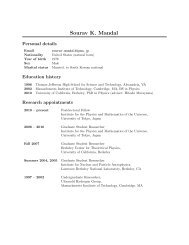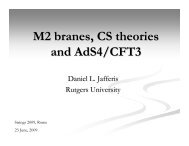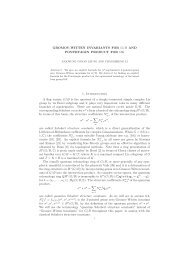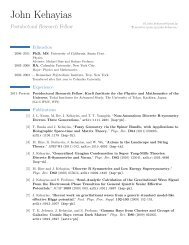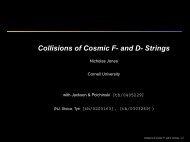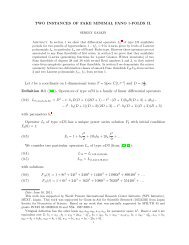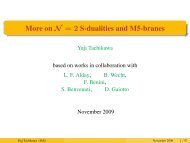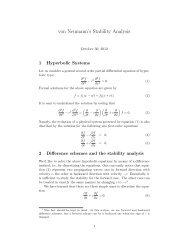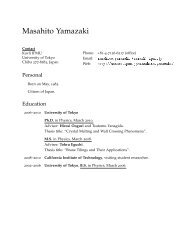STUDY SUMMARY - IPMU
STUDY SUMMARY - IPMU
STUDY SUMMARY - IPMU
You also want an ePaper? Increase the reach of your titles
YUMPU automatically turns print PDFs into web optimized ePapers that Google loves.
<strong>SUMMARY</strong> REPORT<br />
WIDE FIELD FIBER-FED OPTICAL<br />
MULTI-OBJECT SPECTROMETER (WFMOS)<br />
4.2 Reconfiguration Time<br />
In addition to instrument throughput, the other driver of observing efficiency is observational<br />
overhead. In order to minimize overhead, parallel activities are planned. Immediately after the<br />
previous exposure is complete, we begin reading out the three science detectors. Simultaneously<br />
we begin slewing the telescope to the new target location and repositioning the fibers. This involves<br />
illuminating the fibers, imaging the fiber tips with the Metrology camera, computing the<br />
centroids of the imaged fiber tips, and moving the fiber tips. The repositioning sequence is repeated<br />
until the fibers are within tolerance of the object coordinates. The time budget allows six<br />
iterations for fiber positioning.<br />
The fibers are back-lit from the spectrographs and are arranged in the focal plane so that no<br />
two adjacent fibers are illuminated from a single spectrograph. This allows unambiguous identification<br />
since there are overlapping patrol regions. Table 4.2-1 illustrates the activities happening<br />
in parallel. Once the metrology cycle is complete, the Acquisition and Guide System acquires the<br />
guide targets. When the A&G system notifies the Control System that it has a lock, the instrument<br />
starts a new exposure. The entire process will take less than 40 s.<br />
Table 4.2-1: Positioner Configuration Timeline<br />
Start Time Duration (s) Steps being Taken in Parallel<br />
0 1 Move A-1<br />
1 2 Image A-1 Move B-1<br />
3 2 Compute A-1 Image B-1 Move C-1<br />
5 2 Move A-2 Compute B-1 Image C-1<br />
7 2 Image A-2 Move B-2 Compute C-1<br />
9 2 Compute A-2 Image B-2 Move C-2<br />
11 2 Move A-3 Compute B-2 Image C-2<br />
13 2 Image A-3 Move B-3 Compute C-2<br />
15 2 Compute A-3 Image B-3 Move C-3<br />
17 2 Move A-4 Compute B-3 Image C-3<br />
19 2 Image A-4 Move B-4 Compute C-3<br />
21 2 Compute A-4 Image B-4 Move C-4<br />
23 2 Move A-5 Compute B-4 Image C-4<br />
25 2 Image A-5 Move B-5 Compute C-4<br />
27 2 Compute A-5 Image B-5 Move C-5<br />
29 2 Move A-6 Compute B-5 Image C-5<br />
31 2 Image A-6 Move B-6 Compute C-5<br />
33 2 Compute A-6 Image B-6 Move C-6<br />
35 2 Compute B-6 Image C-6<br />
37 1 Compute C-6<br />
38<br />
Read out of Science<br />
Detectors<br />
Move Telescope to<br />
New Position<br />
Acquire Target w/<br />
A&G system<br />
4.3 Allocation Efficiency<br />
An important aspect of any positioner scheme is the efficiency with which the individual<br />
positioner elements can be allocated to the targets of interest for spectroscopy. This allocation<br />
efficiency is a measure of how effectively the spectroscopic capability of the instrument is being<br />
used. WFMOS has been designed to provide high allocation efficiency for both the low and high<br />
spectrograph modes. If the number of targets is very large compared to the number of positioner<br />
elements, then every element will have many targets available to choose from and the positioner<br />
60



